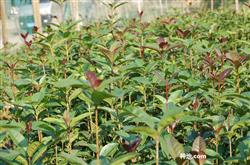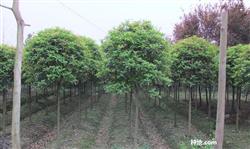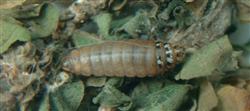How do sweet-scented osmanthus trees sow and raise seedlings?

How do sweet-scented osmanthus trees sow and raise seedlings? Please guide sweet-scented osmanthus generally to use cutting to raise seedlings, and single-stem sweet-scented osmanthus to use sowing to raise seedlings, now introduced as follows: 1. The sweet-scented osmanthus blossoms from September to October and the fruit ripens from late March to late April the following year. When the fruit enters the ripening stage and the pericarp changes from green to purplish black gradually, it can be collected. The collected fruits were piled up for about 3 days. After the peel was softened, the pericarp was soaked and scrubbed, the peel and pulp were removed, and the pure seeds were obtained and slightly dried and moist. Because sweet-scented osmanthus seeds have post-ripening period, it usually takes 8 months for sweet-scented osmanthus seeds to germinate. two。 The method of sowing and raising seedlings is commonly used in raising seedlings. A large number of sweet-scented osmanthus seedlings can be obtained by sowing and raising seedlings, which is suitable to be used as street trees. Sowing commonly used wide strip sowing, row spacing of 20 to 25 cm, width of 10 to 12 cm, 20 kg per mu of sowing, per mu of sweet-scented osmanthus seedlings 2.5 to 30,000. Before sowing, put the navel to one side, cover one or two centimeters of fine soil, cover with a thin layer of straw, and spray water until the soil is soaked to prevent soil consolidation and reduce water evaporation. When the seeds germinated and unearthed, uncover the grass in time and put the grass between the rows, which can not only keep the soil moist, but also prevent the growth of weeds. 3. Maintenance technology (1) weeding in ploughing focuses on loosening soil and weeding in a tree plate with a diameter of 1 meter with the trunk as the center. After irrigation or rainfall, ploughing and loosening the soil is carried out to prevent soil consolidation. (2) the watering and drainage of sweet-scented osmanthus is mainly within one month after the new planting and in the summer of the year. Newly planted sweet-scented osmanthus must be watered and conditionally sprayed with water on the crown of the plant to maintain a certain amount of air humidity. Osmanthus fragrans is not tolerant to waterlogging, timely drainage or transplanting waterlogged plants, and adding a certain amount of sand planting can promote the growth of new roots. (3) rational fertilization should be based on the principle of frequent application of thin fertilizer, mainly available nitrogen fertilizer, and medium and large seedlings should be fertilized three or four times a year. Organic fertilizer was applied in the tree plate in early spring to promote the growth of spring shoots. Inorganic fertilizer or garbage fertilizer should be applied in the early stage of winter. In the meantime, fertilizers can be applied once or twice according to the growth of sweet-scented osmanthus. For newly transplanted sweet-scented osmanthus, topdressing should not be too early. The base fertilizer of the transplanting pit should be mixed with the soil and then covered with soil. (4) shaping and pruning ① peel off the useless buds in the lower part of the trunk during sprouting. ② thinning branches to maintain a certain height under the branches, cut off useless branches, generally sweet-scented osmanthus branches after the height of about 1.5m. ③ cut off the long top branches to keep the sweet-scented osmanthus at a height of about 3.5m and a crown width of 2.5m to 3m. Click to get more sweet-scented osmanthus planting techniques
- Prev

What problems should be paid attention to in the transplantation of sweet-scented osmanthus trees?
What are the common diseases and insect pests in sweet-scented osmanthus trees? How to prevent and cure? The common diseases and insect pests of sweet-scented osmanthus trees are as follows: 1. Leaf spot: the leaf spot is mainly harmful to the leaves, the disease spot is brown, the disease spot is round or irregular, the center is gray to gray in the later stage, the edge is reddish brown, and the disease spot produces black-gray mildew. High temperature and humidity are often.
- Next

How to cut sweet-scented osmanthus trees?
The larvae spit silk to decorate the leaves, bark fragments and so on to create protective sacs, foraging for mesophyll and leaving veins. The injured leaves are porous, which seriously eats all the leaves on the whole tree and can gnaw on the bark. The growth of sweet-scented osmanthus trees was seriously affected. Control methods: remove the protective capsule, reduce the source of insects, and eliminate the overwintering larvae. Protect the predator's umbrella skirt.
Related
- Fuxing push coffee new agricultural production and marketing class: lack of small-scale processing plants
- Jujube rice field leisure farm deep ploughing Yilan for five years to create a space for organic food and play
- Nongyu Farm-A trial of organic papaya for brave women with advanced technology
- Four points for attention in the prevention and control of diseases and insect pests of edible fungi
- How to add nutrient solution to Edible Fungi
- Is there any good way to control edible fungus mites?
- Open Inoculation Technology of Edible Fungi
- Is there any clever way to use fertilizer for edible fungus in winter?
- What agents are used to kill the pathogens of edible fungi in the mushroom shed?
- Rapid drying of Edible Fungi

